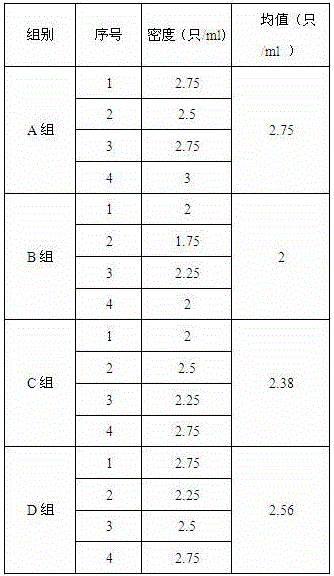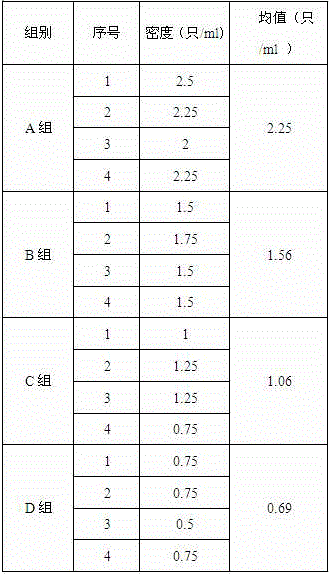Method for indoor low-cost high-density sustainable cultivation of artemia
A breeding method and high-density technology, applied in animal feed, additional food elements, animal feed, etc., can solve problems such as inability to ensure timely supply of Artemia, susceptibility to virus and bacterial contamination, and lack of sustainable cultivation, etc. The effect of continuous breeding, avoiding the interference of weather factors, and reducing the cost of breeding
- Summary
- Abstract
- Description
- Claims
- Application Information
AI Technical Summary
Problems solved by technology
Method used
Image
Examples
Embodiment
[0043] 1) Pre-processing:
[0044] Select volume 10~25m 3 , depth 1.0~1.5m, 16 culture ponds with complete seawater treatment system and air supply system; divide the above 16 culture ponds into four groups of A group, B group, C group and D group, with four ponds in each group; Use natural light, with an average light intensity of 500lux~1200lux; clean the pool before cultivating, use potassium permanganate to make a solution with a concentration of 0.001~0.005mol / L (optimally 0.003mol / L), and then sprinkle it in the pool. After disinfection Rinse with fresh water and use after drying for 2-5 days;
[0045] 2) Fertilizer:
[0046] Inject sand-filtered seawater at 18-25°C (optimally 22°C) into the culture pond, filter the water with a 120-mesh silk screen at the water injection nozzle, and the depth of seawater in the culture pond is 0.6-1.1m (optimally 0.7m). The best actual water body is 10.5m 3 ; Before inoculation, use the fertilizer-water complex to carry out artifici...
PUM
| Property | Measurement | Unit |
|---|---|---|
| Particle size | aaaaa | aaaaa |
| Particle size | aaaaa | aaaaa |
Abstract
Description
Claims
Application Information
 Login to View More
Login to View More - R&D
- Intellectual Property
- Life Sciences
- Materials
- Tech Scout
- Unparalleled Data Quality
- Higher Quality Content
- 60% Fewer Hallucinations
Browse by: Latest US Patents, China's latest patents, Technical Efficacy Thesaurus, Application Domain, Technology Topic, Popular Technical Reports.
© 2025 PatSnap. All rights reserved.Legal|Privacy policy|Modern Slavery Act Transparency Statement|Sitemap|About US| Contact US: help@patsnap.com


